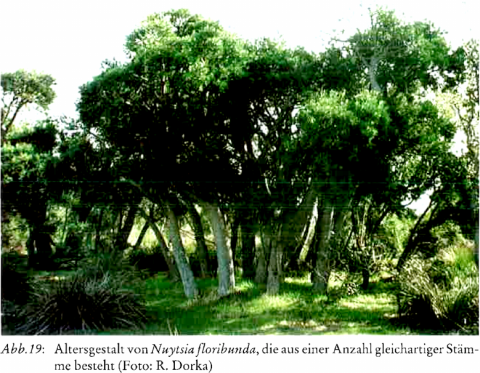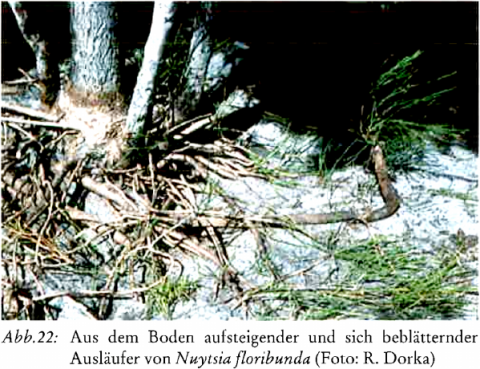Morphologische und physiologische Mosaikbildungen in den Familien Loranthaceae und Viscaceae
Export Article Citation as
- Download price : €6
Abstract:
Development of morphological and physiological mosaics in the Loranthaceae and Viscaceae families
The histories of development of N nytsia flor'ibunda and Viscum album are compared. Both plant species show»morphological«penetrations called mosaics.
N uytsia floribzmda develops a morphological mosaic by penetration of root and shoot materials and a physiological mosaic in the blossom where postflorally the inflorescence axes become green again, continue growing vegetatively and form the next inflorescences from this region.
Viscam album develops a morphological mosaic from the blossom material and pedicle in the case of the female plant and from the perianth and microsporophylls (stamen) in the case of the male. In the region of the root, Viscam album develops a physiological mosaic: instead of a root, the mistletoe forms a vertical primary haustorium at its basal part, with longitudinal bark strands originating from it (organs sui generis), developing secondary haustoriums (sinkers), penetrating the bark of the host tree. From these organs new vegetative shoots may arise.
These mosaic formations correlate with extreme growth forms. Viscum album develops»wood tissue«within the shoot and reduces its size to that of annual plants. Naytsia floribana'a, however, develops a shoot parenchyme and grows to the size of a tree. In the case of Naytsia floribunda, the polar mosaic formations correlate with the shape of an annual herb, having enlarged to the size of a tree. In the case of Viscam album, these polar mosaic formations correlate with the shape of a tree, having reduced to the size of an annual herb.
References
- DORKA, R. (1996): Synchronous differentiation of the meristem into vegetative and gt nerative primordia and nutation movements in Viscum album. In: Sixth Ir ternational Parasitic Weed Symposium, pp. 225-231. Cordoba
- GÖBEL‚ Th. (1994): Erdengeist und Landschaftsseele. Gestaltwirkungen geistiger Wese im Pflanzenreich und in der Mistel. Dornach
- GÖBEL‚ Th. (2002): Zur evolutiven Ausbildung von Blüte rind Frucht bei den Hahnenfußgewächse1 In: Tycho de Brahe-Jahrbuch für Goetheanismus 2002, S. 77-142
- GÖBEL, Th. & DORKA, R. (1986): Zur Morphologie und zur Zeitgestalt der Mistel (Viscur album L.). In: Tycho de Brahe-Jahrbuch für Goetheanismus 1986, S. 167-191 Niefern-Öschelbronn
- MEUSEL, H., JÄGER‚ E. & WEINERT, E. (Hrsg.) (1965): Vergleichende Chorologie de zentraleuropäischen Flora. Kartenband. Jena
- STEINDL, F. (1935): Pollen- und Embryosackentwicklung bei Viscum album L. und Viscu1 articulatum Burm. In: Arbeiten aus dem Institut für Allgemeine Botanik a der Universität Zürich. II. Serie, Nr. 17
- DORKA, R. & HELLRUNG‚ W. (2001): The rhythms of nutational movements in Viscm album L. under constant conditions. In: Per, A. & al. (Eds.), Proceedings of th 7th International Parasitic Weed Symposium, 5.-8.6.2001, pp. 139-142. Name







